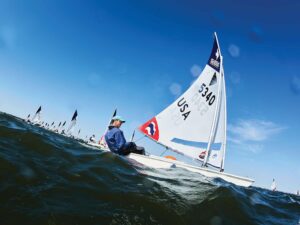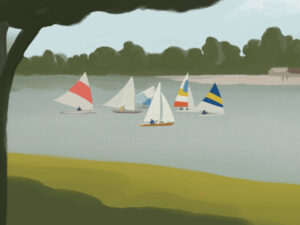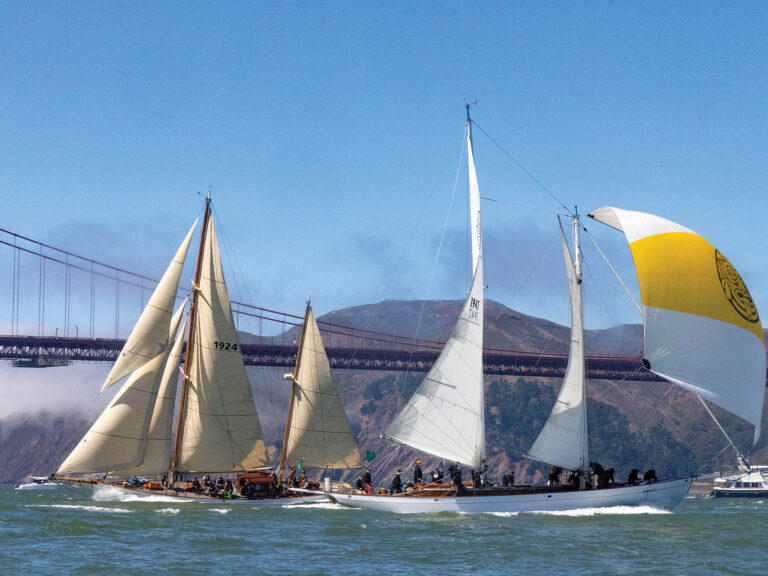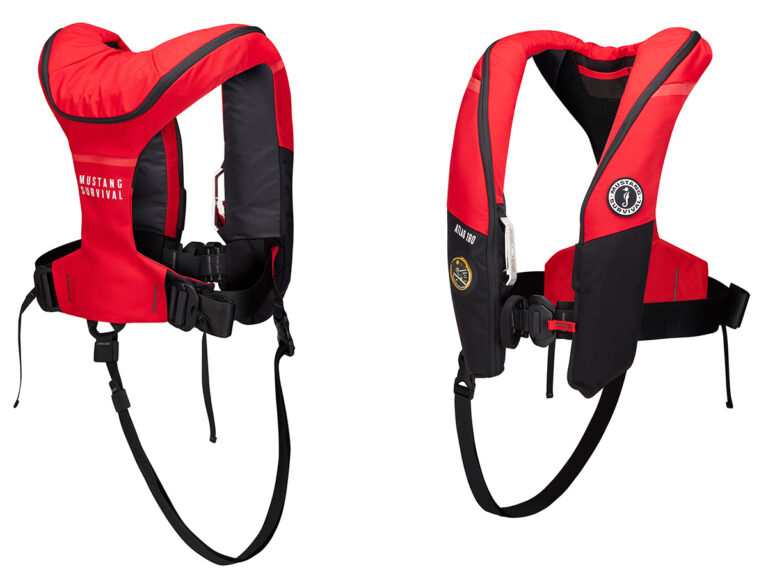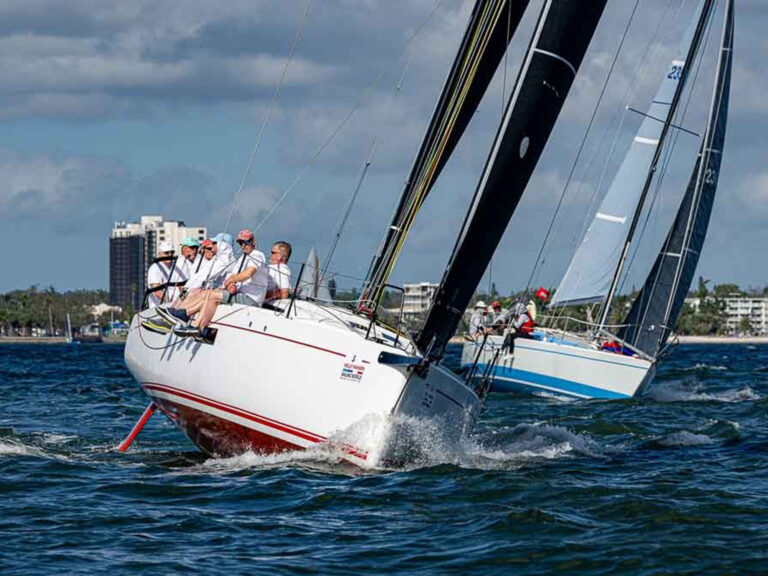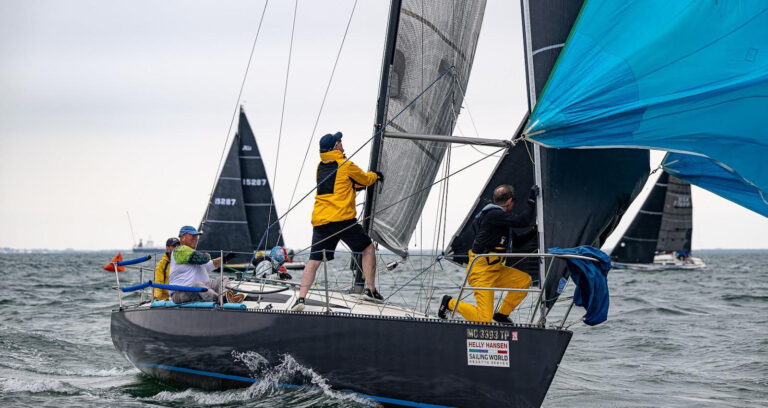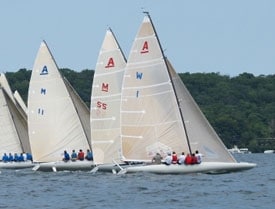
AScowFeat
I had one of those magic starts at the starboard end of the line, and 30 seconds later we were nearly 10 lengths ahead of the other 27 boats in the A Scow Inland Championship. Nice! This was the largest gathering of A Scows in the class’s 107- years history, and what a thrill to be part of it. The wind on Lake Geneva, Wis., was shifty and we tacked frequently. Between tacks, I was immersed in the challenge of heeling the 38-foot rocket to the precise angle to maximize speed. Just off our transom, two scow veterans, John Porter and Rob Evans, were battling each other for the lead in the regatta. It was a unique vantage point from which to watch the Midwest’s best sailors work their magic in one of the fastest one-design classes in the world. It wasn’t long before we were looking at their transoms. At the windward mark we set huge asymmetric spinnakers and took off-or should I say, they took off-and we tried to keep up.I’ve been frequently asked what the best boat to sail is, and my usual answer is to talk about the attributes of a variety of boats. But after steering an A Scow in a full regatta with light, moderate, and heavy winds, the A Scow is cemented at the top of my list.The competition in this class is first-rate. John Porter and his brother Brian are consistently at the top of any fleet they race in, including the Melges 24 class. Their longtime friend, Harry Melges, who’s family has built many of the A boats, was onboard for the Inlands as mainsail trimmer. Their boat was stacked with talent for sure, but they had their hands full. At the start of the regatta’s fifth race (of six) Evans was sitting on a 5-point advantage. The lead in this fifth race went back and forth between the two. In the end, Porter won the race and Evans was second, setting up a 4-point battle for the overall win.Principal race officer Ken Legler started the final race in very light wind. There was no time for a match race. Porter was over early at the port end and had to restart. Now well behind, he bore off and started reaching to find clear wind. Evans was in good shape.Racing along the shoreline at a clip much faster than the rest of the fleet, Porter’s A Scow looked like an optical illusion; within minutes of their restart, the local Lake Geneva crew was challenging for the lead right next to the legendary Buddy Melges. Porter and Melges led all the way to the leeward gate and then the wind disappeared, allowing the rest of us to catch up. It was a mighty big mess as the entire fleet converged. Somehow Porter, using a smaller spinnaker, snaked through to win the race and the regatta. The A’s design was first developed for the Seawanaka Corinthian Cup more than 100 years ago. The design then migrated to Canada before being adopted in the Midwest, where the shallow-hulled, 1,850-pound boat was suited for lake sailing. In the early days, I’m told, A Scows were moved to regattas on hay wagons and even railroad cars. Rigs evolved from gaff-rig to carbon-fiber sloops. These boats sail best when heeled more than 20 degrees, and in a breeze, it takes a lot of courage to do this. The boat rocks up and you feel as if you’re about to be catapulted out of the cockpit. But a subtle tug on the tiller, a slight ease of the main and spinnaker sheets, and zingo, you’re sailing at 25 knots. There’s no crew weight limit, so depending on the wind strength, 5 to 7 crew can be piled on the rail with sailors rotating on or off in between races.Scow sailors are used to 1- to 2-mile legs, but for Race 4 of the championship, Legler set an unusually long 3.4-mile windward leg in 12 knots of wind. To give you a sense of the A’s speed capabilities, it took 28 minutes to reach the top mark and only 10 minutes to sail downwind. That’s a 20.4-knot VMG for the run. That said, crewing on these boats can be exhausting, and only two races were scheduled each day. At one point in the regatta I wondered aloud whether we should have a third race. My crew suggested I trim the spinnaker. I got the point.One of the reasons A’s popularity has taken off of late is the upgrading of the sail plan and use of modern building techniques. With the asymmetric spinnaker they’re faster, easier to sail, and much safer. The fleet’s older boats have all been upgraded with retractable bowsprits, and the Melges clan, the Harkens, and many other Midwest sailors with innovative thinking have made this boat special. A Scows would perform well on many bodies of water, and they are exciting to sail and watch, but they’re not cheap. A new boat, with trailer, sails, and covers costs about $138,000. Used boats go for about half that amount. The scene at the host Lake Geneva YC was fascinating. There is great respect between sailors, despite the strong tribal-like rivalries between the inland lake clubs. Each lake is represented by a letter designation on the sails, a tradition started during the days of cotton sails. Furthering this tradition onshore, many owners have vehicle license plates displaying their boat’s sail numbers. Of course, Buddy Melges’ plates bear I 1.And the names of the boats typically reflect the speeds of which they are capable; Adrenaline, Full Throttle, G Force, Slingshot, Catapult, Fast Forward, and Buck’n A. Our boat, owned by long-time scow sailor Coleman Norris, was called Blue Ribbon, in honor of the beer brewed nearby. Of course, there was a stash onboard.One of the most terrifying moments in an A Scow race is screaming toward the leeward mark at 20-plus knots and performing a “Mexican” takedown. Each time, I threw the double tillers over and hoped for the best. The crew executed the tough maneuver perfectly (even after the Blue Ribbon). On one downwind leg we passed an anchored boat filled with cheering bikini-clad sunbathers. We were at full speed, and somehow still managed to pull off the douse. My crew later thanked me for providing the show.During the regatta, our jib trimmer, Peter Crawford, premiered his film, The Ultimate Ride. He spent two years searching for material to celebrate this storied class, and a crowd of more than 500 showed up to see it. One of my favorite parts of the movie is Hermann Nunnemacher’s story of racing an A Scow in the Chicago to Mackinac Race. They broke their compass and went the wrong way for the first night. A couple of kids in a powerboat got Hermann’s boat back on track and they ended up third boat to finish.

